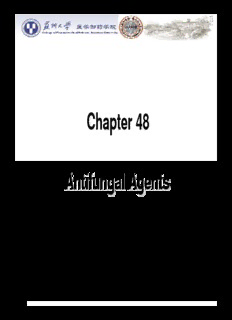
Antifungal Agents PDF
Preview Antifungal Agents
Chapter 48 AAnnttiiffuunnggaall AAggeennttss Fungal infections Superficial Skin Hair Nails Mucous membrane Deep Tissues (muscle & connective tissue) Organs Oral infection with Candida (Thrush) Antifungal drugs • Work by exploiting differences between mammalian and fungal cells to kill the fungal organism without dangerous effects on the host. • Both fungi and humans are eukaryots. • Difficult to find or design drugs that target fungi without affecting human cells. (side effects) WWhhaatt aarree tthhee ttaarrggeettss ffoorr aannttiiffuunnggaall tthheerraappyy?? Cell membrane Fungi use principally ergosterol instead of cholesterol DNA Synthesis Some compounds may be selectively activated by fungi, arresting DNA synthesis. Cell Wall Unlike mammalian cells, fungi have a cell wall AAnnttiiffuunnggaall aaggeennttss Amphotericin B Flucytosine Systemic/systemic Azoles Echinocandins Criseofulvin Systemic/mucocutaneous Terbinafine Nystatine Topical Azoles Topical Topical Allylamines Sites of Action of Antifungal Agents Terbinafine Amphotericin B, Nystatin Fig. 1 Mode action of antifungal drugs I. SYSTEMIC ANTIFUNGAL DRUGS FOR SYSTEMIC INFECTIONS Amphotericin B Amphotericin B is a polyene antibiotic isolated from Streptomyces nodosus. • Broad-spectrum polyene macrolide antibiotic is the most potent antifungal agent for systemic mycosis, in clinical use since 1960 • Fungicidal drug at higher concentrations & static at lower levels. Structure and chemical characteristics • poorly water soluble • administered by IV infusion (0.1 mg/ml) or (0.3 mg/ml) in 5% dextrose • extremely unstable in solution, particularly in normal saline
Description: